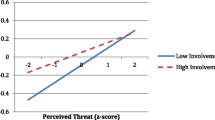Abstract
It was hypothesized that for the child with a birth defect, the accomplishment of certain specific tasks of confrontation of the defect is associated with the child's selfesteem and overall adjustment. These tasks include: (a) emotional confrontation, involving the awareness and free expression of negative feelings associated with the defect; (b) cognitive confrontation, involving the active seeking for an accurate and comprehensive understanding of the causes and manifestations of the defect; and (c) interpersonal confrontation, involving open communication with peers on the subject of the defect. Moreover, it was hypothesized that maternal confrontation of the reality of the child's defect is a factor in facilitating the child's accomplishment of his tasks of confrontation. To test these hypotheses, 35 pre and early adolescent children with birth defects and their mothers were each independently assessed by means of questionnaires and quantitative ratings of semistructured interviews. The results consistently support the hypotheses for cognitive and interpersonal confrontation, but not for emotional confrontation.
Similar content being viewed by others
References
Erikson EH:Childhood and Society. New York, Norton, 1950.
Fishman CA, Fishman DB: Maternal correlates of self-esteem and overall adjustment in children with birth defects.Child Psychiat Hum Dev 1(4):255–65, 1971.
Spock B, Lerrigo MO:Caring for Your Disabled Child. New York, Fawcett World Library, 1967.
Turk J: Impact of cystic fibrosis on family functioning.Pediat 34:67–71, 1964.
Glaser HH, Harrison GS, Lynn DB: Emotional implications of congenital heart disease in children.Pediat 33:367–77, 1964.
Livingson S: The physician's role in guiding the epileptic child and his parents.Amer J Dis Children 119:99–102, 1970.
Caplan G:Principles of Preventive Psychiatry. New York, Basic Books, 1964.
Caplan G, Mason EA, Kaplan DM: Four studies of crisis in parents of prematures.Comm Ment Health J 1:149–61, 1965.
Bandura A:Principles of Behavior Modification. New York, Holt, Rinehart & Winston, Inc, 1969.
Coopersmith S:The Antecedents of Self-Esteem. San Francisco, WH Freeman & Co, 1967.
Crandall VC, Crandall VJ, Katkovsky W: A children's social desirability questionnaire.J Consult Psychol 29:27–36, 1965.
Dubois PH;Multivariate Correlational Analysis. New York, Harper, 1957.
Kincannon JC: Prediction of the standard MMPI scale scores from 71 items: The Mini-Mult.J Consult Clin Psychol 32:319–25, 1968.
Freud S: Mourning and melancholia.Collected Papers, vol 4. London, Hogarth, 1925.
Lindemann E: Symptomatology and management of acute grief.Amer J Psychiat 101:141–48, 1944.
Lazarus A: Learning theory and the treatment of depression.Behav Res Ther 6:83–89, 1968.
Burgess EP: The modification of depressive behaviors. In RD Rubin and CM Franks (Eds),Advances in Behavior Therapy, 1968. New York, Academic Press, 1969.
Centers L, Centers R: Peer group attitudes toward the amputee child.J Soc Psychol 61:127–32, 1963.
Kleck R, Ono H, Hastorf AH: The effects of physical deviance upon face-to-face interaction.Hum Relations 19:425–36, 1966.
Richardson SA, Goodman N, Hastorf AH, et al: Cultural uniformity in reaction to physical disabilities.Amer Sociol Rev 26:241–47, 1961.
Yuker HE, Block JR, Younng JH:The Measurement of Attitudes toward Disabled Persons. New York, Human Resources Center, 1966.
Author information
Authors and Affiliations
Additional information
This investigation was supported, in part, by a Research and Training Center grant (16-P-56815) from the Social and Rehabilitation Service, Department of Health, Education, and Welfare, Washington, D.C.
Rights and permissions
About this article
Cite this article
Fishman, C.A., Fishman, D.B. Emotional, cognitive, and interpersonal confrontation among children with birth defects. Child Psych Hum Dev 2, 92–101 (1971). https://doi.org/10.1007/BF01434642
Issue Date:
DOI: https://doi.org/10.1007/BF01434642



